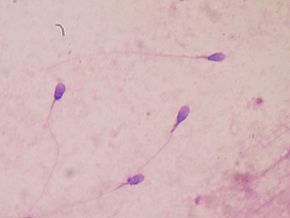 A recent study found that men with infertility have a much higher risk for a variety of other chronic medical conditions, including diabetes, heart disease, renal disease, alcohol abuse, and drug abuse. Thus, it appears that male infertility may be a symptom or a clue that there may be other health problems. One example is that male infertility is linked to an 81% greater risk of diabetes, and the greatest risk for renal disease occurred among men with azoospermia (zero sperm counts, the most severe form of male infertility). From Medscape:
A recent study found that men with infertility have a much higher risk for a variety of other chronic medical conditions, including diabetes, heart disease, renal disease, alcohol abuse, and drug abuse. Thus, it appears that male infertility may be a symptom or a clue that there may be other health problems. One example is that male infertility is linked to an 81% greater risk of diabetes, and the greatest risk for renal disease occurred among men with azoospermia (zero sperm counts, the most severe form of male infertility). From Medscape:
Infertility in Men Tied to Heart Disease, Chronic Conditions
Men with infertility have a higher risk for a variety of other chronic medical conditions, including diabetes, heart disease, alcohol abuse, and drug abuse, according to a retrospective cohort study published online December 7 in Fertility and Sterility."The results suggest that male factor infertility has more than just reproductive implications," write Michael Eisenberg, MD, assistant professor of urology and director of male reproductive medicine and surgery at Stanford University School of Medicine in California, and colleagues.
The researchers used insurance claims data from 2001 to 2008 from the Truven Health MarketScan to identify more than 115,000 patients for the study population. They compared outcomes among 13,027 men diagnosed with male factor infertility (average age, 33 years), with outcomes among 23,860 men (average age, 33 years) who received semen or infertility testing and with outcomes among 79,099 men who had received vasectomies.
The authors looked for 16 conditions: hypertension, diabetes, hyperlipidemia, renal disease, chronic pulmonary disease, liver disease, depression, peripheral vascular disease, cerebrovascular disease, ischemic heart disease, other heart disease, injury, alcohol abuse, drug abuse, anxiety disorders, and bipolar disorder.
The men with infertility had higher rates of obesity and smoking, but even after adjustment for these covariates and for age, follow-up time, and healthcare use, men with infertility had a higher risk for multiple conditions compared with vasectomized men or those receiving only fertility testing. Specifically, compared with the men who received fertility testing, men with infertility had a 30% increased risk for diabetes (hazard ratio [HR], 1.30; 95% confidence interval [CI], 1.10 - 1.53), a 48% increased risk for ischemic heart disease (HR, 1.48; 95% CI, 1.19 - 1.84) and for alcohol abuse (95% CI, 1.07 - 2.05), a 67% increased risk for drug abuse (HR, 1.67; 95% CI, 1.06 - 2.63), and a 19% increased risk for depression (HR, 1.19; 95% CI, 1.04 - 1.36).
Compared with men who received vasectomies, those with infertility had a 9% higher risk for hypertension (HR, 1.09; 95% CI, 1.02 - 1.17), a 14% greater risk for hyperlipidemia (HR, 1.14; 95% CI, 1.07 - 1.22), a 41% greater risk for ischemic heart disease (HR, 1.41; 95% CI, 1.19-1.67), and a 16% greater risk for other heart disease (HR, 1.16; 95% CI, 1.04 - 1.29). Further, men with infertility, compared with vasectomized men, had an 81% greater risk for diabetes (HR, 1.81; 95% CI, 1.57 - 2.08), a 60% greater risk for renal disease (HR, 1.60; 95% CI, 1.14 - 2.24), a 53% greater risk for liver disease (HR, 1.53; 95% CI, 1.31 - 1.80), and a 52% greater risk for peripheral vascular disorders (HR, 1.52; 95% CI, 1.12 - 2.07).




 It seems that a lot has been written about the health benefits of some berries, such as blueberries, while other berries have been neglected. This study focused on red raspberries, black raspberries, and blackberries. While the study was done in Poland, it was pointed out that these berries are also commonly grown in the USA. Red raspberry, black raspberry, and blackberry fruits are abundant in dietary phytochemicals such as flavonols, phenolic acids, ellagitannins, vitamins C and E, folic acid, and β-sitosterol. Many of these bioactive compounds exhibit antioxidant activity. Anthocyanins and other phenolic compounds such as ellagitannins and ellagic acid, which distinguish raspberry from other berries, occur in high levels and are mainly responsible for their broad beneficial health properties (including anti-inflammatory, antimicrobial, and antiviral activities).
It seems that a lot has been written about the health benefits of some berries, such as blueberries, while other berries have been neglected. This study focused on red raspberries, black raspberries, and blackberries. While the study was done in Poland, it was pointed out that these berries are also commonly grown in the USA. Red raspberry, black raspberry, and blackberry fruits are abundant in dietary phytochemicals such as flavonols, phenolic acids, ellagitannins, vitamins C and E, folic acid, and β-sitosterol. Many of these bioactive compounds exhibit antioxidant activity. Anthocyanins and other phenolic compounds such as ellagitannins and ellagic acid, which distinguish raspberry from other berries, occur in high levels and are mainly responsible for their broad beneficial health properties (including anti-inflammatory, antimicrobial, and antiviral activities). Reading this recent study, I was struck by how the results are evidence for eating sulforaphane containing foods, such as kale, cauliflower, brussels sprouts, broccoli, and cabbage for health and preventing cancer (due to anti-tumor activity). It is debatable whether it is support for taking supplements (here a sulforaphane supplement called BSE), even though the researchers were testing the supplement. Seven days of taking a supplement without "serious adverse events" (but they did have minor ones such as "mild abdominal discomfort") is too short a length of time for any support for a product. The real test would be seeing what health effects, both positive and negative, are after a year or two of taking the supplement.
Reading this recent study, I was struck by how the results are evidence for eating sulforaphane containing foods, such as kale, cauliflower, brussels sprouts, broccoli, and cabbage for health and preventing cancer (due to anti-tumor activity). It is debatable whether it is support for taking supplements (here a sulforaphane supplement called BSE), even though the researchers were testing the supplement. Seven days of taking a supplement without "serious adverse events" (but they did have minor ones such as "mild abdominal discomfort") is too short a length of time for any support for a product. The real test would be seeing what health effects, both positive and negative, are after a year or two of taking the supplement. Just a few years ago the type of pesticide (organophosphate, for example chlorpyrifos) looked at in this study was commonly used everywhere - in schools, homes, agriculture. It was easy to buy in stores (e.g., Raid spray), and was considered "safer" than older pesticides. Over time problem after problem has been found with them - with the latest being decreased lung function in children exposed to organophosphates early in life.
Just a few years ago the type of pesticide (organophosphate, for example chlorpyrifos) looked at in this study was commonly used everywhere - in schools, homes, agriculture. It was easy to buy in stores (e.g., Raid spray), and was considered "safer" than older pesticides. Over time problem after problem has been found with them - with the latest being decreased lung function in children exposed to organophosphates early in life. The mother is an important source of the first microbiome for infants by "seeding" the baby's microbiome - from the
The mother is an important source of the first microbiome for infants by "seeding" the baby's microbiome - from the  New research showed that eight days after a concussion, the concussed athletes (football players) looked and felt like they had recovered (clinical recovery), but MRIs showed that there were still neurophysiological abnormalities (significant blood flow decrease) in their brains. They did not look at if and when the blood flow returned to normal, but that research also needs to be done.
New research showed that eight days after a concussion, the concussed athletes (football players) looked and felt like they had recovered (clinical recovery), but MRIs showed that there were still neurophysiological abnormalities (significant blood flow decrease) in their brains. They did not look at if and when the blood flow returned to normal, but that research also needs to be done. This new study gives further support for the role of the appendix as a "natural reservoir for 'good' bacteria". The researchers found that a network of immune cells (innate lymphoid cells or ILCs) safeguard the appendix during a bacterial attack and help the appendix "reseed" the gut microbiome. They also said that a person's diet, such as the proteins in leafy green vegetables, could help produce ILCs. Note that while it is thought that this applies to humans, the research was done on mice. From Medical Xpress:
This new study gives further support for the role of the appendix as a "natural reservoir for 'good' bacteria". The researchers found that a network of immune cells (innate lymphoid cells or ILCs) safeguard the appendix during a bacterial attack and help the appendix "reseed" the gut microbiome. They also said that a person's diet, such as the proteins in leafy green vegetables, could help produce ILCs. Note that while it is thought that this applies to humans, the research was done on mice. From Medical Xpress:
 Loneliness or social isolation is a health risk that can increase the risk of chronic illness and premature death.
Loneliness or social isolation is a health risk that can increase the risk of chronic illness and premature death.